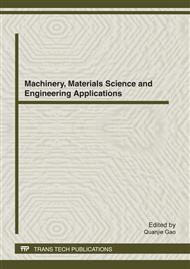p.795
p.799
p.804
p.808
p.812
p.817
p.822
p.827
p.835
An Approach of Tool-Chip Friction Coefficient Estimate for the Simulation of Machining Residual Stress
Abstract:
The tool-chip friction coefficient influences the simulation result of the residual stresses distribution seriously when Finite element software is used to simulate. This paper presents a new tool-chip friction coefficient estimate approach. Frist, a new mathematical model of cutting forces, the cutting speed, feed amount and the tool-chip friction coefficient was established in this paper based on the simulation results of Advant Edge, and then the tool-chip friction coefficient was reversed when the cutting forces are measured. Comparing the simulation residual stress distribution of the friction coefficient in calculation, average coulomb friction coefficient, the default friction coefficient with experimental result; it turns out the distribution of residual stresses in the friction coefficient of calculation approaches to experimental result.
Info:
Periodical:
Pages:
827-834
Citation:
Online since:
April 2012
Authors:
Price:
Сopyright:
© 2012 Trans Tech Publications Ltd. All Rights Reserved
Share:
Citation:


